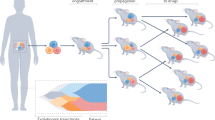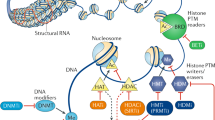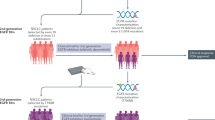Abstract
The genetic and epigenetic underpinnings of cancer are becoming increasingly clear owing to impressive and well-coordinated ventures occurring worldwide. As our understanding of the molecular alterations driving human cancer increases, there is an opportunity to direct the clinical application of cancer therapeutics with improved accuracy. The often empirical treatment of cancer — which was initially based on inhibiting DNA synthesis and cellular division — while having led to a number of remarkable successes, remains prone to a high rate of clinical failure that results partly from a lack of understanding of how best to implement drugs in the clinic. Consequently, it is vital that robust translational strategies be developed preclinically to both reduce failure rates in the clinic and shorten the time required to identify patient populations most likely to benefit from a given therapeutic. Here, we review both historical and current uses of preclinical model systems, being mindful that a combination of approaches will be needed to address all meritorious therapeutic hypotheses.
This is a preview of subscription content, access via your institution
Access options
Subscribe to this journal
Receive 12 print issues and online access
$209.00 per year
only $17.42 per issue
Buy this article
- Purchase on Springer Link
- Instant access to full article PDF
Prices may be subject to local taxes which are calculated during checkout



Similar content being viewed by others
References
Hudson, T. J. et al. International network of cancer genome projects. Nature 464, 993–998 (2010).
Buchdunger, E. et al. Inhibition of the Abl protein-tyrosine kinase in vitro and in vivo by a 2-phenylaminopyrimidine derivative. Cancer Res. 56, 100–104 (1996).
Miller-Moslin, K. et al. 1-amino-4-benzylphthalazines as orally bioavailable smoothened antagonists with antitumor activity. J. Med. Chem. 52, 3954–3968 (2009).
Robarge, K. D. et al. GDC-0449 — a potent inhibitor of the hedgehog pathway. Bioorg. Med. Chem. Lett. 19, 5576–5581 (2009).
Barrie, S. E. et al. Pharmacology of novel steroidal inhibitors of cytochrome P45017α (17 alpha-hydroxylase/C17–20 lyase). J. Steroid Biochem. Mol. Biol. 50, 267–273 (1994).
Bhatnagar, A. S., Hausler, A., Schieweck, K., Lang, M. & Bowman, R. Highly selective inhibition of estrogen biosynthesis by CGS 20267, a new non-steroidal aromatase inhibitor. J. Steroid Biochem. Mol. Biol. 37, 1021–1027 (1990).
Plourde, P. V., Dyroff, M. & Dukes, M. Arimidex: a potent and selective fourth-generation aromatase inhibitor. Breast Cancer Res. Treat. 30, 103–111 (1994).
Sasai, K. et al. Shh pathway activity is down-regulated in cultured medulloblastoma cells: implications for preclinical studies. Cancer Res. 66, 4215–4222 (2006).
Kelly, P. N., Dakic, A., Adams, J. M., Nutt, S. L. & Strasser, A. Tumor growth need not be driven by rare cancer stem cells. Science 317, 337 (2007).
Quintana, E. et al. Efficient tumour formation by single human melanoma cells. Nature 456, 593–598 (2008).
Chabner, B. A. & Roberts, T. G. Jr. Chemotherapy and the war on cancer. Nature Rev. Cancer 5, 65–72 (2005).
DeVita, V. T. Jr & Chu, E. A history of cancer chemotherapy. Cancer Res. 68, 8643–8653 (2008).
Gilman, A. & Philips, F. S. The biological actions and therapeutic applications of the B-chloroethyl amines and sulfides. Science 103, 409–436 (1946).
Goodman, L. S. et al. Nitrogen mustard therapy; use of methyl-bis(beta-chloroethyl)amine hydrochloride and tris(beta-chloroethyl)amine hydrochloride for Hodgkin's disease, lymphosarcoma, leukemia and certain allied and miscellaneous disorders. JAMA 132, 126–132 (1946).
Rutman, R. J., Cantarow, A. & Paschkis, K. E. Studies in 2-acetylaminofluorene carcinogenesis. III. The utilization of uracil-2-C14 by preneoplastic rat liver and rat hepatoma. Cancer Res. 14, 119–123 (1954).
Heidelberger, C. et al. Fluorinated pyrimidines, a new class of tumour-inhibitory compounds. Nature 179, 663–666 (1957).
Fantini, A., Moser, L., Partridge, R. & Halliday, J. L. The effect of actinomycin D on several mouse tumors. Proc. Am. Assoc. Cancer Res. 2, 108 (1956).
Farber, S. Carcinolytic action of antibiotics: puromycin and actinomycin D. Am. J. Pathol. 31, 582 (1955).
Gregory, F. J., Hata, T., Pugh, L. H. & Thielen, R. The effect of actinomycin D on experimental ascitic tumors in the mouse. Cancer Res. 16, 985–987 (1956).
Johnson, I. S., Armstrong, J. G., Gorman, M. & Burnett, J. P. Jr. The vinca alkaloids: a new class of oncolytic agents. Cancer Res. 23, 1390–1427 (1963).
Pinkel, D. Actinomycin D in childhood cancer; a preliminary report. Pediatrics 23, 342–347 (1959).
Shoemaker, R. H. The NCI60 human tumour cell line anticancer drug screen. Nature Rev. Cancer 6, 813–823 (2006).
Holbeck, S. L., Collins, J. M. & Doroshow, J. H. Analysis of Food and Drug Administration-approved anticancer agents in the NCI60 panel of human tumor cell lines. Mol. Cancer Ther. 9, 1451–1460 (2010).
Bussey, K. J. et al. Integrating data on DNA copy number with gene expression levels and drug sensitivities in the NCI-60 cell line panel. Mol. Cancer Ther. 5, 853–867 (2006).
Garraway, L. A. et al. Integrative genomic analyses identify MITF as a lineage survival oncogene amplified in malignant melanoma. Nature 436, 117–122 (2005).
Ma, Y. et al. Predicting cancer drug response by proteomic profiling. Clin. Cancer Res. 12, 4583–4589 (2006).
Ring, B. Z., Chang, S., Ring, L. W., Seitz, R. S. & Ross, D. T. Gene expression patterns within cell lines are predictive of chemosensitivity. BMC Genomics 9, 74 (2008).
Ross, D. T. et al. Systematic variation in gene expression patterns in human cancer cell lines. Nature Genet. 24, 227–235 (2000).
Scherf, U. et al. A gene expression database for the molecular pharmacology of cancer. Nature Genet. 24, 236–244 (2000).
Solit, D. B. et al. BRAF mutation predicts sensitivity to MEK inhibition. Nature 439, 358–362 (2006).
Weinstein, J. N. et al. An information-intensive approach to the molecular pharmacology of cancer. Science 275, 343–349 (1997).
Bai, R. L. et al. Halichondrin B and homohalichondrin B, marine natural products binding in the vinca domain of tubulin. Discovery of tubulin-based mechanism of action by analysis of differential cytotoxicity data. J. Biol. Chem. 266, 15882–15889 (1991).
Leteurtre, F., Kohlhagen, G., Paull, K. D. & Pommier, Y. Topoisomerase II inhibition and cytotoxicity of the anthrapyrazoles DuP 937 and DuP 941 (Losoxantrone) in the National Cancer Institute preclinical antitumor drug discovery screen. J. Natl Cancer Inst. 86, 1239–1244 (1994).
Solary, E. et al. Dual inhibition of topoisomerase II and tubulin polymerization by azatoxin, a novel cytotoxic agent. Biochem. Pharmacol. 45, 2449–2456 (1993).
Adams, J. Development of the proteasome inhibitor PS-341. Oncologist 7, 9–16 (2002).
Weir, B. A. et al. Characterizing the cancer genome in lung adenocarcinoma. Nature 450, 893–898 (2007).
Zhao, X. et al. Homozygous deletions and chromosome amplifications in human lung carcinomas revealed by single nucleotide polymorphism array analysis. Cancer Res. 65, 5561–5570 (2005).
Ding, L. et al. Somatic mutations affect key pathways in lung adenocarcinoma. Nature 455, 1069–1075 (2008).
Rodig, S. J. et al. Unique clinicopathologic features characterize ALK-rearranged lung adenocarcinoma in the western population. Clin. Cancer Res. 15, 5216–5223 (2009).
Soda, M. et al. Identification of the transforming EML4–ALK fusion gene in non-small-cell lung cancer. Nature 448, 561–566 (2007).
McDermott, U. et al. Genomic alterations of anaplastic lymphoma kinase may sensitize tumors to anaplastic lymphoma kinase inhibitors. Cancer Res. 68, 3389–3395 (2008).
McDermott, U. et al. Identification of genotype-correlated sensitivity to selective kinase inhibitors by using high-throughput tumor cell line profiling. Proc. Natl Acad. Sci. USA 104, 19936–19941 (2007).
Kwak, E. L. et al. Anaplastic lymphoma kinase inhibition in non-small-cell lung cancer. N. Engl. J. Med. 363, 1693–1703 (2010).
Shaw, A. T. et al. Clinical features and outcome of patients with non-small-cell lung cancer who harbor EML4–ALK. J. Clin. Oncol. 27, 4247–4253 (2009).
Koivunen, J. P. et al. EML4–ALK fusion gene and efficacy of an ALK kinase inhibitor in lung cancer. Clin. Cancer Res. 14, 4275–4283 (2008).
Soda, M. et al. A mouse model for EML4–ALK-positive lung cancer. Proc. Natl Acad. Sci. USA 105, 19893–19897 (2008).
Dry, J. R. et al. Transcriptional pathway signatures predict MEK addiction and response to selumetinib (AZD6244). Cancer Res. 70, 2264–2273 (2010).
Greshock, J. et al. Molecular target class is predictive of in vitro response profile. Cancer Res. 70, 3677–3686 (2010).
Lin, W. M. et al. Modeling genomic diversity and tumor dependency in malignant melanoma. Cancer Res. 68, 664–673 (2008).
Sos, M. L. et al. Predicting drug susceptibility of non-small cell lung cancers based on genetic lesions. J. Clin. Invest. 119, 1727–1740 (2009).
Davies, B. R. et al. AZD6244 (ARRY-142886), a potent inhibitor of mitogen-activated protein kinase/extracellular signal-regulated kinase kinase 1/2 kinases: mechanism of action in vivo, pharmacokinetic/pharmacodynamic relationship, and potential for combination in preclinical models. Mol. Cancer Ther. 6, 2209–2219 (2007).
Yeh, J. J. et al. KRAS/BRAF mutation status and ERK1/2 activation as biomarkers for MEK1/2 inhibitor therapy in colorectal cancer. Mol. Cancer Ther. 8, 834–843 (2009).
Engelman, J. A. et al. Effective use of PI3K and MEK inhibitors to treat mutant Kras G12D and PIK3CA H1047R murine lung cancers. Nature Med. 14, 1351–1356 (2008).
Wee, S. et al. PI3K pathway activation mediates resistance to MEK inhibitors in KRAS mutant cancers. Cancer Res. 69, 4286–4293 (2009).
Borisy, A. A. et al. Systematic discovery of multicomponent therapeutics. Proc. Natl Acad. Sci. USA 100, 7977–7982 (2003).
Sos, M. L. et al. Identifying genotype-dependent efficacy of single and combined PI3K- and MAPK-pathway inhibition in cancer. Proc. Natl Acad. Sci. USA 106, 18351–18356 (2009).
Engelman, J. A. & Janne, P. A. Mechanisms of acquired resistance to epidermal growth factor receptor tyrosine kinase inhibitors in non-small cell lung cancer. Clin. Cancer Res. 14, 2895–2899 (2008).
Kobayashi, S. et al. EGFR mutation and resistance of non-small-cell lung cancer to gefitinib. N. Engl. J. Med. 352, 786–792 (2005).
Pao, W. et al. Acquired resistance of lung adenocarcinomas to gefitinib or erlotinib is associated with a second mutation in the EGFR kinase domain. PLoS Med. 2, e73 (2005).
Engelman, J. A. et al. MET amplification leads to gefitinib resistance in lung cancer by activating ERBB3 signaling. Science 316, 1039–1043 (2007).
Turke, A. B. et al. Preexistence and clonal selection of MET amplification in EGFR mutant NSCLC. Cancer Cell 17, 77–88 (2010).
Beroukhim, R. et al. Assessing the significance of chromosomal aberrations in cancer: methodology and application to glioma. Proc. Natl Acad. Sci. USA 104, 20007–20012 (2007).
Li, A. et al. Genomic changes and gene expression profiles reveal that established glioma cell lines are poorly representative of primary human gliomas. Mol. Cancer Res. 6, 21–30 (2008).
Wakimoto, H. et al. Human glioblastoma-derived cancer stem cells: establishment of invasive glioma models and treatment with oncolytic herpes simplex virus vectors. Cancer Res. 69, 3472–3481 (2009).
Ellis, W. J. et al. Characterization of a novel androgen-sensitive, prostate-specific antigen-producing prostatic carcinoma xenograft: LuCaP 23. Clin. Cancer Res. 2, 1039–1048 (1996).
Klein, K. A. et al. Progression of metastatic human prostate cancer to androgen independence in immunodeficient SCID mice. Nature Med. 3, 402–408 (1997).
Korenchuk, S. et al. VCaP, a cell-based model system of human prostate cancer. In Vivo 15, 163–168 (2001).
Lee, Y. G. et al. Establishment and characterization of a new human prostatic cancer cell line: DuCaP. In Vivo 15, 157–162 (2001).
Wainstein, M. A. et al. CWR22: androgen-dependent xenograft model derived from a primary human prostatic carcinoma. Cancer Res. 54, 6049–6052 (1994).
Rong, S. et al. Tumorigenicity of the met proto-oncogene and the gene for hepatocyte growth factor. Mol. Cell Biol. 12, 5152–5158 (1992).
Tian, H. et al. Hedgehog signaling is restricted to the stromal compartment during pancreatic carcinogenesis. Proc. Natl Acad. Sci. USA 106, 4254–4259 (2009).
Yauch, R. L. et al. A paracrine requirement for hedgehog signalling in cancer. Nature 455, 406–410 (2008).
Sharpless, N. E. & Depinho, R. A. The mighty mouse: genetically engineered mouse models in cancer drug development. Nature Rev. Drug Discov. 5, 741–754 (2006).
Olive, K. P. et al. Inhibition of Hedgehog signaling enhances delivery of chemotherapy in a mouse model of pancreatic cancer. Science 324, 1457–1461 (2009).
Buonamici, S. et al. Interfering with resistance to smoothened antagonists by inhibition of the PI3K pathway in medulloblastoma. Sci. Transl. Med. 2, 51ra70 (2010).
Zhou, Y. et al. Chimeric mouse tumor models reveal differences in pathway activation between ERBB family- and KRAS-dependent lung adenocarcinomas. Nature Biotech. 28, 71–78 (2010).
Kinzler, K. W. & Vogelstein, B. Landscaping the cancer terrain. Science 280, 1036–1037 (1998).
Kaiser, J. Cancer research. Looking for a target on every tumor. Science 326, 218–220 (2009).
Druker, B. J. et al. Efficacy and safety of a specific inhibitor of the BCR–ABL tyrosine kinase in chronic myeloid leukemia. N. Engl. J. Med. 344, 1031–1037 (2001).
Bollag, G. et al. Clinical efficacy of a RAF inhibitor needs broad target blockade in BRAF-mutant melanoma. Nature 467, 596–599 (2010).
Vogel, C. L. et al. Efficacy and safety of trastuzumab as a single agent in first-line treatment of HER2-overexpressing metastatic breast cancer. J. Clin. Oncol. 20, 719–726 (2002).
Fremin, C. & Meloche, S. From basic research to clinical development of MEK1/2 inhibitors for cancer therapy. J. Hematol. Oncol. 3, 8 (2010).
Baum, M. et al. Anastrozole alone or in combination with tamoxifen versus tamoxifen alone for adjuvant treatment of postmenopausal women with early breast cancer: first results of the ATAC randomised trial. Lancet 359, 2131–2139 (2002).
Danila, D. C. et al. Phase II multicenter study of abiraterone acetate plus prednisone therapy in patients with docetaxel-treated castration-resistant prostate cancer. J. Clin. Oncol. 28, 1496–1501 (2010).
Reid, A. H. et al. Significant and sustained antitumor activity in post-docetaxel, castration-resistant prostate cancer with the CYP17 inhibitor abiraterone acetate. J. Clin. Oncol. 28, 1489–1495 (2010).
Ryan, C. J. et al. Phase I clinical trial of the CYP17 inhibitor abiraterone acetate demonstrating clinical activity in patients with castration-resistant prostate cancer who received prior ketoconazole therapy. J. Clin. Oncol. 28, 1481–1488 (2010).
Drew, Y. & Plummer, R. PARP inhibitors in cancer therapy: two modes of attack on the cancer cell widening the clinical applications. Drug Resist. Updat. 12, 153–156 (2009).
Acknowledgements
We thank C. Emery and W. Hable for providing constructive feedback during the writing of this article.
Author information
Authors and Affiliations
Corresponding author
Ethics declarations
Competing interests
Giordano Caponigro and William R. Sellers are employees and shareholders of Novartis Pharmaceuticals.
Related links
Glossary
- Caretaker genes
-
The primary function of caretaker genes is to maintain the integrity of the genome. When mutated these genes are tumour suppressor genes, whereby their loss of function can indirectly promote tumorigenesis by increasing the rate of DNA mutation in cells. Examples of genes in this class include ATM, BRCA1/2, MLH and MSH2. P53 can act as both a caretaker and as a gatekeeper gene.
- Cell Line Encyclopedia Project
-
A collaborative project between the Novartis Institutes for BioMedical Research and the Broad Institute in which ∼1,000 cancer cell lines are being characterized in terms of mRNA expression, copy-number alterations and point mutations. The project also includes large-scale compound sensitivity profiling.
- Driver mutation
-
This is a genetic event in cancer that is statistically enriched across many representatives of a tumour type. It is different to a 'passenger' mutation, which may be acquired and propagated in much fewer tumours by a chance linkage with a driver mutation. Well-established druggable driver oncogenes include BCR–ABL, human epidermal growth factor receptor 2 (HER2; also known as ERBB2), KIT, platelet-derived growth factor receptor (PDGFR), EGFR and BRAF.
- GI50
-
The drug concentration required to causes a 50% growth inhibitory effect.
- NCI60
-
A collection of 57 cancer cell lines developed and used for high-throughput cytotoxicity assays. More than 50,000 compounds have been tested in this cell line set.
Rights and permissions
About this article
Cite this article
Caponigro, G., Sellers, W. Advances in the preclinical testing of cancer therapeutic hypotheses. Nat Rev Drug Discov 10, 179–187 (2011). https://doi.org/10.1038/nrd3385
Published:
Issue Date:
DOI: https://doi.org/10.1038/nrd3385
This article is cited by
-
Applications of lung cancer organoids in precision medicine: from bench to bedside
Cell Communication and Signaling (2023)
-
Esophageal organoids: applications and future prospects
Journal of Molecular Medicine (2023)
-
The potential application of organoids in breast cancer research and treatment
Human Genetics (2022)
-
Microvascularized tumor organoids-on-chips: advancing preclinical drug screening with pathophysiological relevance
Nano Convergence (2021)
-
Gastrointestinal cancer organoids—applications in basic and translational cancer research
Experimental & Molecular Medicine (2021)



